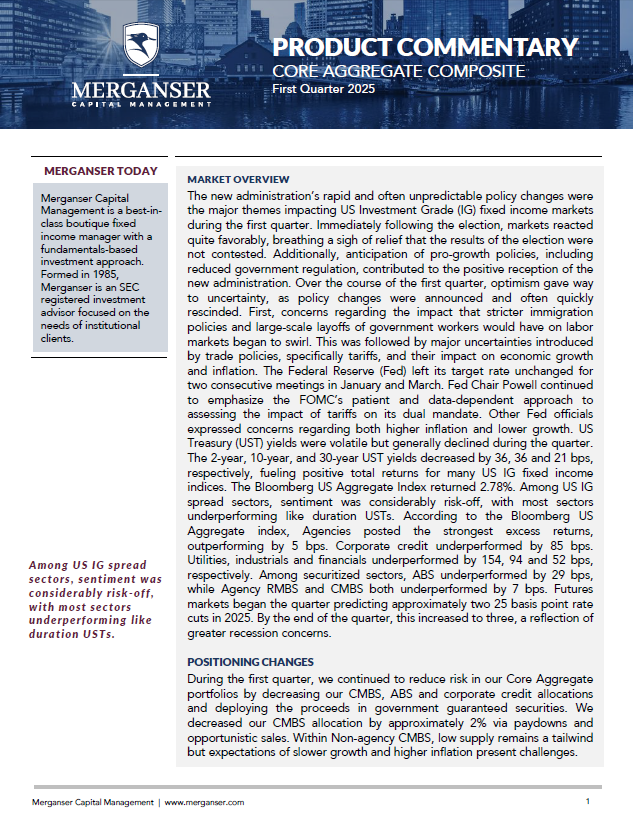MARKET OVERVIEW
The new administration’s rapid and often unpredictable policy changes were the major themes impacting US Investment Grade (IG) fixed income markets during the first quarter. Immediately following the election, markets reacted quite favorably, breathing a sigh of relief that the results of the election were not contested. Additionally, anticipation of pro-growth policies, including reduced government regulation, contributed to the positive reception of the new administration. Over the course of the first quarter, optimism gave way to uncertainty, as policy changes were announced and often quickly rescinded. First, concerns regarding the impact that stricter immigration policies and large-scale layoffs of government workers would have on labor markets began to swirl. This was followed by major uncertainties introduced by trade policies, specifically tariffs, and their impact on economic growth and inflation. The Federal Reserve (Fed) left its target rate unchanged for two consecutive meetings in January and March. Fed Chair Powell continued to emphasize the FOMC’s patient and data-dependent approach to assessing the impact of tariffs on its dual mandate. Other Fed officials expressed concerns regarding both higher inflation and lower growth. US Treasury (UST) yields were volatile but generally declined during the quarter. The 2-year, 10-year, and 30-year UST yields decreased by 36, 36 and 21 bps, respectively, fueling positive total returns for many US IG fixed income indices. The Bloomberg US Aggregate Index returned 2.78%. Among US IG spread sectors, sentiment was considerably risk-off, with most sectors underperforming like duration USTs. According to the Bloomberg US Aggregate index, Agencies posted the strongest excess returns, outperforming by 5 bps. Corporate credit underperformed by 85 bps. Utilities, industrials and financials underperformed by 154, 94 and 52 bps, respectively. Among securitized sectors, ABS underperformed by 29 bps, while Agency RMBS and CMBS both underperformed by 7 bps. Futures markets began the quarter predicting approximately two 25 basis point rate cuts in 2025. By the end of the quarter, this increased to three, a reflection of greater recession concerns.
POSITIONING CHANGES
During the first quarter, we continued to reduce risk in our Core Aggregate portfolios by decreasing our CMBS, ABS and corporate credit allocations and deploying the proceeds in government guaranteed securities. We decreased our CMBS allocation by approximately 2% via paydowns and opportunistic sales. Within Non-agency CMBS, low supply remains a tailwind but expectations of slower growth and higher inflation present challenges. High-quality spreads continue to mirror the movement of IG corporate credit, albeit with a lag. We are avoiding office and favor Single-Asset Single-Borrower (SASB) for targeted credit exposures, though credit enhancement has decreased. Troubled office and retail deals are likely to tarnish SASB’s historically strong track record, and while realized losses are growing within the sector as problem loans are being resolved, this serves to reduce uncertainty moving forward. We decreased our ABS allocation by approximately 1%. Primary market spreads in traditional ABS segments offer a modest spread concession compared to secondary market opportunities. While collateral performance has shown some deterioration, deals remain well enhanced even in Subprime where deterioration has been significantly more pronounced. Many esoteric ABS subsectors continue to appear overvalued and are likely to experience greater spread volatility in the current environment. We modestly decreased our corporate credit allocation, where spreads ended the quarter still near historic tights, and we remain underweight vs. the benchmark. Longer maturity industrial spreads are reflecting value consistent with a positive fundamental outlook, but they do not account for potential risks from M&A activity, balance sheet-leveraging transactions, or economic downturn scenarios. While we remain supportive of the general industrial sector, we believe current spreads do not fully price in downside risk. Domestic utilities are well insulated from geopolitical impacts and protected from commodity volatility/inflation through rate-base adjustments. Current spreads largely reflect the benefit of highly visible cash flows across this sector and are at or near full value. Spreads of utilities with exposure to wildfire risk remain notably wider with continued uncertainty on potential litigation that is likely to take years to resolve. Banking saw significant tightening in 2024 following the March 2023 crisis. We remain constructive on the “too big to fail” banks and will take advantage of new issuance, though we still anticipate spread volatility, particularly in Yankee and regional banks. In REITS, market confidence has rebounded significantly, resulting in limited compensation for risks related to funding costs and uncertainty over property values. We modestly reduced our allocation to Agency RMBS. Nominal and option-adjusted spreads for 30-year mortgages were rangebound during the quarter. Despite the recent increase in rate volatility, spreads have remained firm, likely due to inflows to mortgage funds and increased demand from banks. The proceeds from the reductions in our allocations to the spread sectors were deployed in US Treasuries, where our allocation increased by approximately 4%. Our overall duration positioning was unchanged at neutral vs. the benchmark. Thirty-year credit continues to look exceptionally rich and is our largest underweight in terms of key rate durations. We are overweight the 6-7-year part of the curve, which is largely a reflection of our Agency RMBS exposure.
OUTLOOK
A global economic realignment is underway and ‘tariff on/off’ feels like the new ‘risk on/off’ moniker for markets. The whipsaw is taking a toll on corporations and consumer sentiment; not to mention global trade flows and our trade partners’ psyche. Domestic economic growth feels more tenuous than it did coming into 2025, and potential outcomes are more uncertain. Labor markets show modest signs of softening (unemployment up to 4.1%) but the three-month moving average for job growth is strong at 200k (Feb ’25) and barely changed from 203k (Feb ’24). The Fed’s outlook has shifted to lower growth and higher inflation since their last meeting. At the March meeting Chairman Powell reiterated the Fed’s position that they are not in a rush to lower rates but still have two cuts penciled in for the balance of 2025. Volatility at the long end of the curve has been dramatic with a nearly 100 basis point range for the 10-year since the first Fed cut in September. The front end of the curve continues to track with expectations of Fed cuts in the future. While recent data has shown continued progress toward lower inflation, inflation expectations are rising on volatile trade policies. University of Michigan 1-year and 5–10-year expectations have both risen sharply and bear watching.
Corporate Credit spreads, while materially wider than the trough, remained expensive at quarter end. The eased regulatory backdrop has led to a blitz of M&A activity, pressuring future industrial balance sheets, but setting up a strong 2025 for money center banks. We continue to prefer shorter exposures and remain circumspect when it comes to Tech, Pharma/Healthcare, Retail, and Autos. Agency Mortgage spreads currently provide modest incremental value on a risk adjusted basis versus other spread sectors. Despite the recent rally in 10-year Treasury yields, 30-year mortgage rates remain sticky, leaving much of the universe out-of-the-money. While we view this government guaranteed sector as providing a reasonable rate of return and exceptional liquidity, we don’t see a catalyst for spread tightening in the near term. While most consumer credit strata are showing signs of weakness, the relative weakness varies dramatically between prime and subprime. Collateral performance in prime receivables continues to show a modest increase in delinquencies. Many subprime shelves and unsecured consumer loans have deteriorated noticeably and bear watching. We are avoiding the subprime market entirely and focusing on the highest quality consumer and commercial related collateral. CMBS sentiment has shifted as concerns about growth have widened spreads in sympathy with corporate credit. We are approaching levels where the compensation for risk is sufficient to reinvest cashflows back into the sector at the top of the capital structure. The domestic nature of CMBS cash flows provides some cushion to global trade concerns, but ultimately corporate America pays the rent and potential upward pressure on longer rates presents risks. The market’s appetite for risk has improved with successful new SASB office deals in San Francisco, Houston and Chicago, three challenged markets.


